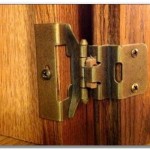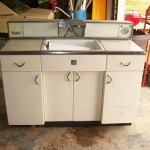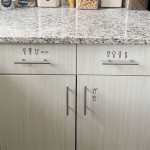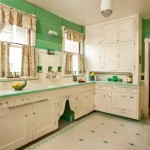Easy Ways To Clean Kitchen Cabinets
Kitchen cabinets are a focal point in any kitchen, subject to daily use and exposure to grease, grime, and food splatters. Maintaining clean cabinets contributes significantly to the overall kitchen hygiene and aesthetics. This article outlines effective and easy methods for cleaning various types of kitchen cabinets.
Before embarking on the cleaning process, it is crucial to identify the cabinet material. Different materials require specific cleaning approaches to prevent damage. Common kitchen cabinet materials include wood, laminate, metal, and painted surfaces. Determining the cabinet material will guide the selection of appropriate cleaning solutions and tools.
For wood cabinets, a gentle approach is recommended. Harsh chemicals can strip the wood of its natural oils and finish. A mixture of mild dish soap and warm water is an effective cleaning solution. Mix a few drops of dish soap into a bucket of warm water. A soft cloth or sponge should be dampened with the solution, wrung out thoroughly to avoid excess water, and used to wipe down the cabinet surfaces. Excess moisture can damage wood, so it's essential to dry the cabinets immediately with a clean, dry cloth.
Cleaning painted cabinets requires similar care to avoid damaging the paint. A solution of warm water and a mild all-purpose cleaner is generally safe for painted surfaces. As with wood cabinets, it's crucial to wring out the cleaning cloth thoroughly and dry the cabinets immediately after cleaning. For stubborn stains, a paste of baking soda and water can be applied to the affected area and gently rubbed in a circular motion. This mild abrasive can help lift stains without damaging the paint.
Laminate cabinets are relatively low-maintenance and resistant to stains. They can be cleaned with a variety of cleaning solutions, including all-purpose cleaners, vinegar solutions, or even commercial laminate cleaners. A soft cloth or sponge dampened with the chosen cleaner can be used to wipe down the surfaces. Avoid abrasive cleaners or scouring pads, as these can scratch the laminate surface. Rinsing with a clean, damp cloth and drying thoroughly is recommended.
Metal kitchen cabinets, often found in modern kitchens, can be cleaned with a simple solution of warm soapy water or a specialized stainless steel cleaner. For general cleaning, a mixture of dish soap and warm water is sufficient. Apply the solution with a soft cloth or sponge and rinse thoroughly. For stainless steel cabinets, a dedicated stainless steel cleaner can help remove fingerprints and maintain the shine. Always follow the manufacturer's instructions when using specialized cleaning products.
Grease buildup is a common issue in kitchens, particularly on cabinets near the stovetop. A mixture of baking soda and water can be an effective grease-cutting solution. Create a paste by mixing baking soda with a small amount of water and apply it to the greasy areas. Let the paste sit for a few minutes to allow the baking soda to absorb the grease, then gently scrub with a soft cloth or sponge. Rinse with clean water and dry thoroughly.
Inside the cabinets can also accumulate dust, crumbs, and spills. Regular cleaning of cabinet interiors is essential for maintaining kitchen hygiene. Remove all items from the cabinets before cleaning. Wipe down the shelves and interior surfaces with a damp cloth and a mild cleaning solution. For stubborn spills or sticky residues, a solution of white vinegar and water can be effective. Ensure the cabinets are completely dry before replacing the stored items.
Maintaining clean kitchen cabinets requires regular cleaning and attention. Wiping down cabinet surfaces after each use can prevent the buildup of grease and grime. A more thorough cleaning, including the cabinet interiors, should be performed at least once a month. Addressing spills and splatters promptly can also prevent staining and make regular cleaning easier.
Choosing the right cleaning tools is essential for effective and safe cleaning. Microfiber cloths are highly absorbent and effective at trapping dirt and dust. Sponges can be useful for scrubbing stubborn stains, but it's important to choose non-abrasive sponges to avoid scratching delicate surfaces. Soft-bristled brushes can be helpful for cleaning intricate details or crevices.
Protecting clean cabinets is crucial for maintaining their appearance and extending their lifespan. Avoid using harsh chemicals or abrasive cleaners, which can damage the cabinet finish. Regularly wiping down surfaces with a damp cloth can prevent the buildup of grime and make deep cleaning less frequent. Consider using cabinet liners to protect shelves from spills and scratches. Addressing spills and splatters promptly can also prevent staining and make regular cleaning easier.
By following these simple cleaning methods and choosing the right cleaning solutions for the specific cabinet material, maintaining clean and attractive kitchen cabinets can be a manageable task.

How To Clean Your Kitchen Cabinets

How To Clean White Kitchen Cabinets 3 Best Ways Avoid Abbotts At Home

9 Ways To Get Low Maintenance Kitchen Cabinets

7 Secrets For Easy To Clean Kitchen Cabinets Quad City Bath

How To Design A Kitchen That S Easy Clean

How To Clean Kitchen Cabinets 9 Basics Bob Vila

Degrease Kitchen Cabinets With An All Natural Homemade Cleaner

5 Expert Ways To Clean Wooden Kitchen Cabinets Everyday Old House

How To Deep Clean Kitchen Cabinets And Keep Them Looking Gorgeous Everyday Skate

How To Clean Kitchen Cabinets This Genius Trick Will Save You So Much Time
Related Posts








